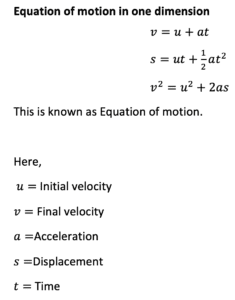
Introduction
The motion refers to the change in an object’s position over time and is defined by its velocity, distance, acceleration, displacement, speed, and time. The motion of an object is always measured with respect to some frame of reference. Motion can occur in one, two, or three dimensions, where one-dimensional motion is linear, two is on a plane, and three involves movement in space.
One-dimensional motion is the simplest form of motion. When an object moves in a straight line or in a particular direction we called it one-dimensional motion. For example the motion of a car on a straight road. it is a part of classical mechanics.
What is one-dimensional motion?
The motion of a particle moving in a straight line or in a particular direction is known as one-dimensional motion. Also called rectilinear motion.
Example
1. A Woman walking on a straight path.
2. Train moving on a straight railway track.
3. The motion of a falling object.
4. Motion of a vehicle must be in a straight line.
Description
One-dimensional motion is an earlier part of classical mechanics. In this part, we discuss how to represent motion. At first, we try to know some quantity.
1. Speed
Speed is the rate of change of distance in any direction. Speed does not have any direction, so speed is a scalar quantity.
The formula of speed is distance divided by time.
2. Distance
The length of the path between two points in a straight line is called distance. Distance is a scalar quantity.
The formula of distance is speed multiplied by time.
3. Time
The measurable period during a process continues. It has only magnitude and no direction. so, time is a scalar quantity.
4. Velocity
The rate at which an object changes its position is called velocity. It is a vector quantity. The formula of velocity is displacement divided by time. The unit of velocity is a meter per second.
5. Displacement
The position of the particle relative to the origin is called displacement. It is a vector quantity. The unit of displacement is a meter.
6. Acceleration
Acceleration is the rate of change of velocity with time. It is also a vector quantity. The unit of acceleration is a meter per second squared.
There are two types of rectilinear motion.
1. Uniform one-dimensional motion with constant velocity.
2. Non-uniform one-dimensional motion with variable velocity.
Uniform one-dimensional motion
When an object moved in a straight line and embeds an equal amount of distance in an equal interval of time.
For example, if a vehicle moved at a speed of 90 km/hour, it will cover 1.5 km/minute. In this case, the motion of the vehicle acceleration is constant.
Non-uniform one-dimensional motion
When the velocity of an object covers unequal amounts in equal intervals of time .
Example- If a car covered a distance of 5 km but after every one kilometer the car changed its speed. It means the car changes its velocity at every point. so, the acceleration is not constant. It is a non-uniform one-dimensional motion.
Equation of motion in one dimension

Derivation of equation
1. Derivation of the first equation
Acceleration = rate of change of velocity
a = change in velocity/time
Change in velocity = Final velocity – initial velocity
a = v – u/t
at = v – u
at + u = v
v = u + at
this is the first equation of one – dimensional motion.
2. Derivation of the second equation
Vaverage = u + v/2
We know, v = u + at
So putting it in the equation
Vaverage = u + u + at/2
We also know, v = s/t
Putting it in the equation, we can write
S/t = 2u + at/2
S = 2ut + at2/2
S = ut + ½ at2
This is the second equation of one-dimensional motion.
3. Derivation of the third equation
v = u + at
v2 = u2 + 2at + a2t2
v2 = u2 + 2a (ut + ½ at 2)
As we know from the second equation, s = ut + 1/2at2
v2 = u2 + 2as
This is the third equation of one-dimensional motion.
Two-dimensional motion
The motion which takes place in two different directions at the same time is called two-dimensional motion. In two-dimensional motion, we study the vector nature of displacement, velocity, and acceleration.
As a one-dimensional motion, we drive the kinematics equations for two-dimensional motion from the fundamental definition of these three quantities.
Projectile motion and uniform circular motion is a special case of two-dimensional motion. For two-dimensional motion, the path of a particle can be represented with three vectors.
One vector shows the distance between the initial and final points of the motion. The other two vectors show the horizontal and vertical components of the motion. Circular motion is also a two-dimensional motion.
Example
1. The motion of the earth around the sun.
2. Motion of a ship in the river.
3. Motion of an insect on a floor.
Three-dimensional motion
The motion that occurs in three dimensions is called three-dimensional motion. Simply the motion which incorporates all the X, Y, and Z-axis. To describe this we need three parameters, position, velocity, and acceleration.
Example
1. Movement of the gyroscope.
2. Motion of a flying bird in the sky.
3. The motion of a kite.
4. Motion of an airplane.
Difference between one, two, and three-dimensional motion
One-dimensional motion |
Two-dimensional motion | Three-dimensional motion | |
| 1. | Study of movement in one direction. | It is the movement in two directions. | Study of movement in three directions. |
| 2. | This is described as the motion of a particle in a straight line. | This type of motion described the motion of particles in a plane. | This type of motion described the motion of a particle in space. |
| 3. | The motion of a car in a straight line | Example-motion of a car in a circular path. | Example-motion of a flying bird. |
Problems
1. A girl throws a ball vertically upwards with an initial velocity of 20ms-1 then catches it sometime later. Calculate the time taken for the ball to return to the same height as it was released.
Taking upwards as positive.
We know, v=u+at
u = 20 ms-1
v = -20 ms-1
a = -9.8 ms-2
t = ?
-20 = 20+ (-9.8)t
-9.8t = -40
t = -40/ – 9.8 = 4.08 sec
2. Starting from rest, a motorcycle is capable of achieving a constant acceleration of 6 m/s2 until it reaches a maximum speed of 55 m/s. At what time (t) and coordinate (x f) the motorcycle reaches its maximum speed?
According to the third equation of one-dimensional motion, we know,
v2 = u2 + 2as
v2 = u2 + 2a (xf – xi)
Displacement (s) = final displacement (x f) – initial displacement ( xi)
According to the question
xi =0
xf = ?
u (Initial velocity) = 0
v (Final velocity) = 55 m/s
a (Acceleration) = 6 m/s2
(Time) = ?
Putting the given values in this equation, we get,
552 = 12xf
xf = 3025/12
xf = 252.083 m
For calculating time we used the first equation of one-dimensional motion,
v = u + at
55 = 6t
t = 55/6
t = 9.16 sec
3. A car accelerates from a velocity of 12 m/s to a velocity of 50 m/s in a distance of 800 m. calculate the acceleration of the car?
According to the third equation of one-dimensional motion,
v2 = u2 + 2as
Here, u = 12 m/s
v = 50 m/s
s = 500 m
a = ?
So putting the values in the equation, we get,
502 = 122 + 2a (800)
a = 2500 – 144 / 1600
a = 2356 / 1600
a = 1.4725 m/s2
Q&A
1. What is one-dimensional motion?
When a particle moves in a straight line or the motion of a particle in a particular direction is known as a one-dimensional motion.
Example
- A woman walking on a straight path,
- A train on a straight railway track.
2. What dimension are we living in now?
In everyday life, we live in three dimensions. It has breadth, height, and width.
3. What is a 2-dimensional motion?
That takes place in two different directions at the same time is called a two-dimensional motion.
Example- Motion of the earth around the sun.
4. What does it mean to move in one-dimensional motion?
Motion along a straight line is a one-dimensional motion. The line used for one-dimensional motion is familiar to the x-axis. The object may move forward or backward along this line. Forward is usually considered a positive movement. Moving in backward is considered a negative movement.
Written By: Sumita Banerjee
Reference
https://ncert.nic.in/textbook.php?leph1=0-8
